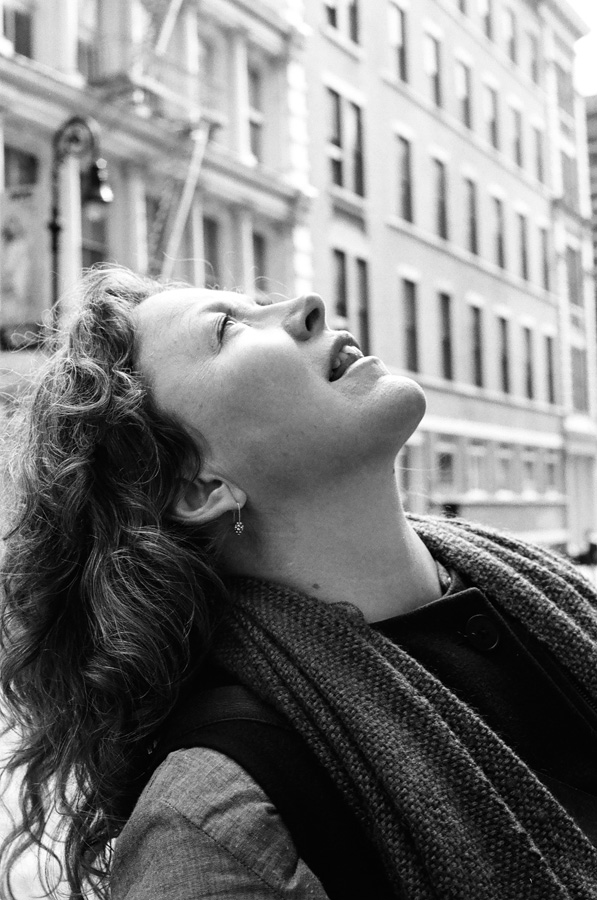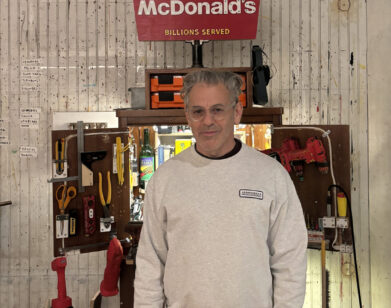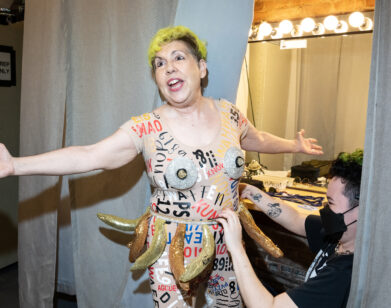KatrÃn Sigurdardóttir’s Sequence of Experience
ABOVE: KATRÍN SIGURDARDÓTTIR. PHOTOS BY JEFF HENRIKSON
Katrín Sigurdardóttir’s sculptures and installations redefine preconceptions surrounding architecture, history, and memory. Her work is defined by lack of presence: rooms without people or color, and interiors pared down to anonymous essentials that quietly exist as markers of the artist’s specific memories. In 2003’s Impasse II, for example, the artist recreated the façade of her childhood elementary school as a miniature. Without any specific reference to location, or details, the piece appears almost as an architectural study—its poetics only revealed upon the acquisition of background information.
Sigurdardóttir often employs exacting processes like cartography or architectural model making into her work, but the tension lies in the inexact nature of what she is rendering. In this way, Sigurdardóttir is less concerned with the language of architecture than with the architecture of language, with fluid nuances and room for reinterpretation and projection. In 2012’s Stage, the artist displayed a miniature theater stage, suspended in an empty storefront and illuminated by a spotlight. It is this masterful control of information, which renders in viewers an empty hollowness, at once lovely and intriguing.
Currently based in New York, Sigurdardóttir will be representing Iceland at the 55th Venice Biennale, opening in June. It is a well-deserved honor for the artist, who has exhibited, lectured, and diligently and prolifically created at a diverse array of venues, including the Metropolitan Museum of Art, MoMA PS1, and Art in General.
We sat down with Sigurdardóttir to discuss her upcoming work in Venice, the role of the institution, and her thoughts on the Icelandic language of cultural production.
HANNAH MANDEL: What was it like finding out that you’d be representing Iceland in the Biennale? Was it a long process or was it more of a surprise?
KATRÍN SIGURDARDÓTTIR: It was both a surprise and not a surprise. That’s something arrogant to say, but it was something I’d hoped for, for a long time, but nevertheless I was not prepared when I was told. Everything in my life has been sort of dedicated to this project from the moment I found out.
MANDEL: Are you excited about the other representatives this year, and the people that you’ll be showing with?
SIGURDARDÓTTIR: Very much so, I believe I knew relatively early on. I was probably one of the early announcements, and it’s been quite wonderful since then to find out little by little who the other representatives are. It’s very joyful, because there are many other people that I know, that I’ve worked with.
MANDEL: Have you worked with either of the curators that you’re working with before?
SIGURDARDÓTTIR: I’ve known both of them for a very long time. Mary [Ceruti] I have known since my days in San Francisco in the ’90s—early ’90s, late ’80s. She was with Capp Street Projects, but I was not in the role of an artist then. I would often admire her work there. We sort of re-met in New York about maybe 10 years ago. We’ve never formally worked together, but we’ve always been in contact. She’s followed my work and I’ve followed hers. Ilaria [Bonacossa] and I have worked together several times in Italy. Both of them are people who have been very much in my life over a long period of time. It’s wonderful to have an opportunity to work with both of them. I’m Icelandic and I’m representing my country of birth, but Ilaria and Mary also represent my other origins, you could say.
MANDEL: I know that you had said that you had trained as a filmmaker. In a lot of work I see this reference to this kind of secondary or removed viewing process. I wonder if your background as a filmmaker and the idea that the camera can capture the set has influenced the way that you work, and view things.
SIGURDARDÓTTIR: I haven’t thought of it this way, but I do think my two origins are from painting and filmmaking. In sculpture and sculptural installation, I think I’m very concerned with sequence of experience. In many works of art there is not a time element in how you take it in, but through navigation and interaction with the work, you are bound to experience things in sequence and over time. And it’s very important what happens first and what happens next, in a similar way as it would be in film.
MANDEL: You mentioned your background as a painter. Can you tell me a little about your thoughts on using color and where that comes from?
SIGURDARDÓTTIR: When I was painting, and I still paint, I’ve always been very considered with the painting as an object. I think a lot about painting as a surface object. My sculpture always deals a lot with surface. It usually has a very two-sided aspect to it, where you have one side, perhaps an illusionistic surface, and the other you have the structure that shows how this illusion is created. I don’t think I use color in a very traditional or classical sense. I think I use color actually more as one could think that a sculptor uses color. I am more concerned with the living color of a material, usually. In this piece [for Venice], it’s a little bit different because the surface that I’ve made is actually pigmented. I’m using natural pigments to make a color. When I use color, I’m very sparse. I use a lot of white and sometimes black, and when I use black I don’t often think of it as black. I think of it as ink. I might use an inkwash that happens to be black, but the black isn’t there to represent anything. Or the white is a reference to, say, a contemporary gallery space. The color is to represent not an emotion or a sensibility, but more a reference to something that exists. In this case I wanted to choose colors that would be kind of subdued but also on some level unexpected, in a way to abstract this surface that I am presenting.
MANDEL: What is very interesting about the way you work in relation to what I understand architecture to be is that architecture is based in fact, in math, in modeling, and a lot of the ideas that you’re dealing with are based in something that’s intangible, a memory. To create something exacting out of something that is abstract, is where this really interesting tension is. What do you think about the space between the replica and the reenactment? For example, in Impasse, was it important that the details were exactly right, or were you building from something you remembered?
SIGURDARDÓTTIR: I think maybe the premise of this whole reenactment of architectural drawing, or drafting, or cartography for that matter, has to do with choosing a language or form of representation that is concrete and unemotional. To try to present the opposite of what it is meant to handle, or contain. That’s something that just kind of developed without me realizing it, but something I can’t un-realize when I look at it. Let’s say that the outcome of what I make often takes these quasi-scientific forms of representation. The way I produce them is also in certain opposition, because my methodology is not architectural or cartographical. It’s very personal, and usually not like a workshop. Many artists who work with architecture, they work like architects in the sense that they have design, and then have a team of people that execute. I don’t work like that in most instances. In this project, a little bit less so, but historically I don’t work like that.
MANDEL: That was actually my next question—is the way you work similar to an architect, creating models and using software?
SIGURDARDÓTTIR: I’ve always been interested in the concrete, factual understanding of space and of function in space, but not necessarily to the same effect as an architect would. My drawing and my construction are never about solving functional problems. I’m interested in functionality, but I’m not interested in proposing functionality.
MANDEL: In looking at the places that you have shown work, it’s so varied. Your work deals so much with space, with the architecture of the environment. It must be very different to show in a room at the Met, which is so infused with very specific history, versus showing in a “white cube” type space. In terms of Venice, is that something you’re considering, with the history of the Biennale and Venice?
SIGURDARDÓTTIR: I think what I did at the Metropolitan Museum was very in the context of that environment, whereas the work that I’m doing in Venice is originally not in any sort of response to the Biennale, or to Venice, this incredible historical site. They’re both museums, in a sense. This was really not the spark of the project, but this work inadvertently echoes the whole topography of Venice in some way. That’s something I think is interesting and exciting, and I don’t in any way try to control that experience of the work. As often is the case, when a work is started, there’s a certain vision and intention, and when the work comes into being, when it comes into the world, it has brought with it aspects and qualities that one doesn’t necessarily see in the beginning. In this way, I also don’t work as a designer or architect often would, where there’s this fully conceived model and it’s executed. There’s something that happens in the process, as when you paint a painting—you paint, and you look, and you paint, and you look—the creation is happening all along. I give the work a certain freedom to relate to its environment in this case.
MANDEL: You’ve lectured pretty extensively at different art schools and art institutions, and you went to the San Francisco Art Institute. As someone who is a working artist, what do you think the role of the art school right now is?
SIGURDARDÓTTIR: I think that the academic environment is extremely important. I think this is true in all professions. Most professions intersect with the market and the academy. People who are professional in any field often have a presence in the academic field through research and through sharing their excellence, or whatever, with students in an academic setting. I, as an artist and as a person, am a learner. When I’m an educator, I’m also a learner. It’s hard to say what the role of an art school is, per se, but I don’t like to think of schools as a factory, where something goes in and something comes out. I like to think of it more as an open forum. It’s a very important environment, no less so for artists that are not there to pursue a degree, but who are there to mediate or give back. During the time that I was making the exhibition at the Metropolitan Museum, I was also a professor at the Icelandic Academy of Arts. It’s difficult to divide your time between a very large project like the show at the Met, and between my students, but I also know that being in that dialogue with my student was extremely giving and generous to me. It should never be underestimated, how generous an experience it is to work in that environment. So I didn’t answer your question. [laughs]
MANDEL: I think that in expressing that you have faith in the role of the school, you did answer my question. I’ve read about people discussing how your work fits into the vernacular of Icelandic artists creating work. Can you tell me about what that vernacular is, or what you see it to be? I’ve read that you see Iceland as a very small country, and the idea that people have a very different idea of public and private space from the United States.
SIGURDARDÓTTIR: I think we who are part of this community of artists in Iceland, we are very much part of an international community. There are many particularities. One of them is the fact that we speak this language that about 300,000 people in the world speak. Visual art is wonderful because it’s international. It’s a language that’s ours, but it’s a language that we don’t have to translate. I think there’s a very strong literary tradition in Iceland, and a strong tradition of poetry. There’s a very linguistic base to work that is made in Iceland, but it’s linguistic without language itself, sometimes with the structure of the language, but it is depicted differently. I’m not very fond of trying to invent or pinpoint what Icelandic art is. I’m very proud to represent this community of artists, but I don’t want that in any way to preclude us from being seen as part of a much larger community. We are all sort of dialoguing with each other through our eyes and through our experiences. There’s not really a national boundary there. Most of us are showing internationally as well as in Iceland. I think what connects us is more the community itself than specific sensibilities.
MANDEL: For a country that’s very small, there seems to be such a large creative community.
SIGURDARDÓTTIR: Thankfully, there’s been an understanding that being very important. In order for us to define who we are as Icelandic, there are a lot of cultural productions needed. That’s how we say who we are. I’ve been asked recently if my work is really Icelandic, or that my particular work doesn’t have a reference to Iceland, and I think that part of what artists do is that they help to define what it means to be a human being, what it means to be a human being in a particular place, what it means to be part of a certain community. We are the ones who give form to that. In literature, we are the ones who create this. I don’t go to my work with the mission of telling people what it is to be Icelandic, or even what it means to be me, per se. That’s not the motive of my work. But nevertheless, that’s one of the results of an artist’s work.
KATRÍN SIGURDARDÓTTIR WILL REPRESENT ICELAND IN THE VENICE BIENNALE STARTING JUNE 1, 2013.







